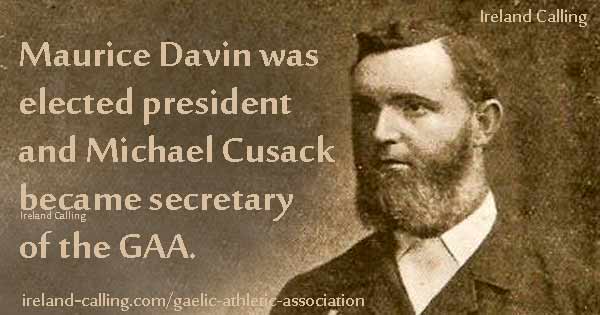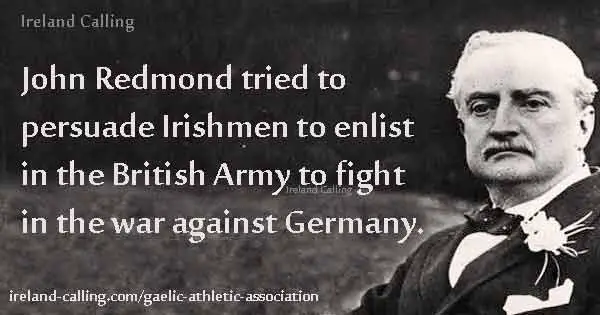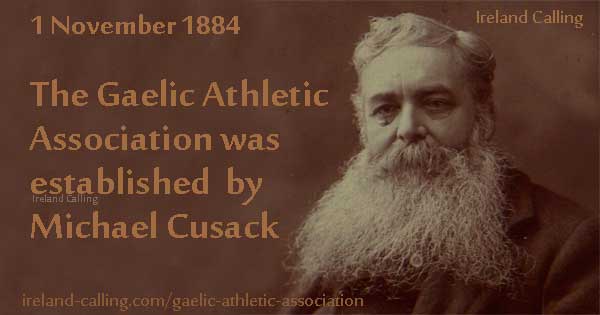The Gaelic Athletic Association (GAA) was established in 1884 to promote Irish sports and pastimes but from the outset it also performed a much wider role, the fostering of Irish nationalism.
It wasn’t an overtly political organisation but it disapproved of the way British sport and culture was so widespread in Ireland. It tried to play down British influence and so wouldn’t allow police officers or members of the British Army to become members.
The Irish Republican Brotherhood, which would later be the driving force behind the 1916 Easter Rising, saw the GAA as an ideal recruiting ground and infiltrated it almost as soon as it was formed. Many of the rebels who fought in the Rising were members of the GAA.
The Gaelic Athletic Association was established on 1 November 1884 by Michael Cusack. Cusack was a teacher who set up his own school to help students prepare for the entrance exams into the British Civil Service.
Sport was highly regarded at Cusack’s Academy but he became dismayed at the popularity of British sports such as rugby and cricket and the declining use of Irish games. He set about trying to rectify the situation.
In 1882, he became one of the founding members of the Dublin Hurling Club, which was formed to re-establish the national game of hurling. There was no central body managing the sport at that time and each area played to slightly different rules, making competition difficult. Cusack realised that not only hurling but other games needed a governing body to standardise rules if they were to survive and grow.
A word about Irish Athletics


He wrote an article to that effect called ‘A word about Irish Athletics’ which was published in the nationalist newspapers, United Ireland, and the Irishman. It was well received across Ireland and came to the attention of Maurice Davin from Tipperary. He was one of three brothers who were all prominent athletes at that time. He wrote to Cusack pledging his support.
Cusack then organised a meeting at the Hayes Hotel in Thurles and the GAA was formed under the title: Gaelic Athletic Association for the Preservation and Cultivation of national Pastimes. Davin was elected president and Cusack became secretary.
The organisation then asked three of the champions of Irish nationalism to become patrons: Archbishop Thomas Croke, after whom Croke Park was later named, Charles Stewart Parnell, who was campaigning for Home Rule for Ireland, and Michael Davitt, one of the leaders of the Land League, campaigning for improved rights for tenant farmers.
The choice of such leading nationalist figures left no one in any doubt that this was to be a uniquely Irish organisation. This led to conflicts almost immediately and within a few years there was a split due to political differences. By 1887, two factions had emerged; one side supported the Irish Republican Brotherhood in its willingness to use force to achieve Irish independence, the other side wanted to follow the purely peaceful route to Home Rule advocated by the Irish Parliamentary Party.
At the Annual Congress in 1887, the leader of the IRB faction Edward Bennett won the election for president and ousted Maurice Davin. The pro-Home Rule group left to set up an alternative organisation. Matters were resolved within a year when Archbishop Croke brought the two sides back together and Davin was re-instated as president.
It was significant that the temporary split in the organisation was along political grounds because, although the promotion of sport would remain the organisation’s primary function, politics was always there in the background.
GAA members took part in the Land War and Easter Rising

GAA members played a part in the Land War, often turning up in numbers, armed with hurling sticks to prevent evictions of tenant farmers. They were also prominent at political meetings and demonstrations. In 1914, Thomas Kent called in GAA members to disrupt a speech by the leader of the Irish Parliamentary Party, John Redmond at Dungourney in Cork. Redmond was trying to persuade Irishmen to enlist in the British Army to fight in the war against Germany.
Kent got the GAA stage a parade and march with hurleys over their shoulders creating both noise and a hostile atmosphere. Kent would later be executed in the wake of the Easter Rising after guns were found at his home and he and his brothers were involved in a shoot-out with police.
The GAA as a body played no part in the Easter Rising but many of its members did on an individual basis having joined other organisations such as the IRB, the Irish Volunteers or the Irish Citizen Army. So many members were arrested and imprisoned after the Rising that the GAA almost ground to a halt until they were released.
The British authorities were alarmed at how many members took part in the Rising and concerned that matches drew big crowds that were difficult to police and control. In 1918, it announced that hurling and football matches could not be staged without an official permit. The GAA responded by staging a meeting on 20 July, 1918 when it was decided that no member or club should apply for a permit under any circumstances. Anyone who did would automatically be suspended.
The GAA then decided to openly defy British authority by staging what became known as Gaelic Sunday on 4 August, 1918. This involved staging matches involving 50,000 people all over the country. Not one of the games had a permit. The protest was too big to deal with and with little they could do, the authorities backed down.
Bloody Sunday – 14 shot dead at Croke Park GAA match
In 1920, the GAA found itself unwittingly caught up in the most tragic event in Irish sport. The Irish War of Independence was at its height. The British had a crack team of undercover agents and ruthless assassins, known as the Cairo Gang because of a café where they often met. It had been very successful in infiltrating nationalist groups involved in the war.
The leader of the Irish Republican Army, Michael Collins, had his own crack team known simply as the Squad. On November 21, 1920, the Squad assassinated several members of the Cairo Gang at several locations across Dublin. Later that day, in retaliation, British soldiers opened fire on the crowd at Croke Park killing 14 people.
The day became known as Bloody Sunday.
GAA continues to organise and promote Irish sports
The GAA maintained its opposition to British sports for most of the 20th century. It had an exclusion rule preventing members playing or showing support for foreign games. No one was exempt from this rule, not even the President of Ireland, Douglas Hyde. Mr Hyde was removed as a patrol of the GAA in December 1938 because he attended the Ireland v Poland soccer game in Dublin. The fact that he was expected to attend in his official capacity as president made no difference.
While politics often influenced GAA activity, its primary function was always to promote Irish sports. It standardised the rules of the main Irish games and as early as 1888 set about promoting Irish sport in America. About 50 Irish athletes staged exhibitions and organised games against local players in several American cities.
As well as promoting Irish sport, they hoped to raise money to finance the staging of the legendary tournaments of the past, the Tailteann Games, in Dublin. Unfortunately for the 50 athletes, the tour lost money and they had to appeal to Michael Davitt to pay their fares back to Ireland.
By 1913, however, the GAA was thriving and raising enough money to establish a national sports stadium in Dublin, Croke Park, named in honour of the archbishop who had been an early patron and sometime peacemaker between opposing factions.
The GAA is still a vibrant organisation today. It has lost most of its former political associations and now focuses purely on promoting the Irish sports of hurling, camogie, Gaelic football, handball and rounders, as well as Irish music and dancing.
